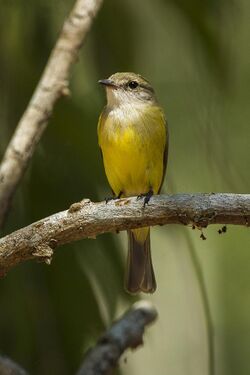Biology:Lemon-bellied flyrobin
| Lemon-bellied flyrobin | |
|---|---|

| |
| Scientific classification | |
| Domain: | Eukaryota |
| Kingdom: | Animalia |
| Phylum: | Chordata |
| Class: | Aves |
| Order: | Passeriformes |
| Family: | Petroicidae |
| Genus: | Microeca |
| Species: | M. flavigaster
|
| Binomial name | |
| Microeca flavigaster Gould, 1843
| |
| Synonyms | |
| |
The lemon-bellied flyrobin or lemon-bellied flycatcher (Microeca flavigaster) is a species of bird in the family Petroicidae. Found in Australia , Indonesia, and Papua New Guinea, its natural habitats are subtropical or tropical moist lowland forests and subtropical or tropical mangrove forests.
Taxonomy
John Gould described the species in 1843 from a specimen from Port Essington in the Northern Territory.[2] The species name is from the Latin word flavus meaning 'yellow', and Ancient Greek gaster meaning 'belly'.[3] Four subspecies are recognised: the nominate flavigaster is found across the top of the Northern Territory, subspecies flavissima in Cape York and New Guinea, subspecies laetissima along the central-northern Queensland coast, and subspecies tormenti in the Kimberley of northwestern Australia.[4] The two Queensland subspecies are separated by the Atherton Tableland and Burdekin-Lynd Divide, and are possibly kept apart by a population of the jacky winter (Microeca fascinans) that replaces it in some areas.[5] Genetic analysis shows that the two Queensland subspecies are very closely related, but that there is quite a large separation from subspecies flavigaster. Subspecies tormenti was not sampled in that study.[6]
Subspecies tormenti, known as the Kimberley flyrobin, was considered a separate species for many years. It is unusual in that it lacks the yellow pigmentation of the other subspecies.[4] Les Christidis and Walter Boles reclassified it as a subspecies, since hybrids between subspecies tormenti and flavigaster have been found in the vicinity of Cambridge Gulf—between the ranges of the two subspecies.[7][8]
As well as lemon-bellied flyrobin, the species is also commonly known as lemon-breasted flycatcher (from when belly was thought crude), yellow-bellied flycatcher, yellow-breasted flycatcher, or brown-tailed flycatcher (subspecies tormenti).[3]
Description
The adult lemon-bellied flyrobin is around 11.5 centimetres (4.5 in) long.[9] The sexes have similar plumage. The nominate subspecies flavigaster has lemon yellow underparts, a white throat, grey face with a white eyebrow stripe, and olive-brown upperparts. Subspecies tormenti has white underparts, more greyish upperparts, has a longer bill and tail and is larger overall. Subspecies flavissima resembles flavigaster but has a more obvious yellow tinge to the upperparts, throat, yellow eyebrow and a shorter tail, while laetissima more closely resembles flavigaster, but has a shorter tail and bill and is larger overall.[4]
Distribution and habitat
The species ranges from the Ord River in the west to coastal Queensland, and is found in mangroves, paperbark swamp forests, and woodland.[9]
Feeding
The lemon-bellied flyrobin is an insectivore, hunting its prey in the foliage or dead branches of trees and shrubs and only rarely on the ground.[10] Fieldwork in Kakadu National Park found that it occasionally caught large insects over 2 centimetres (0.79 in) in length; insects were generally caught by the bird hawking or sallying.[10]
Breeding
Breeding throughout its range, the lemon-bellied flyrobin breeds from August to February, raising one or two broods a season. The nest is a small dish-shaped structure made of bark and grasses in the fork of a tree. A single egg measuring 19 by 14 millimetres (0.75 by 0.55 in) is laid, pale blue with brownish markings.[11]
References
- ↑ BirdLife International (2017). "Microeca flavigaster". IUCN Red List of Threatened Species 2017: e.T103736933A118827297. doi:10.2305/IUCN.UK.2017-3.RLTS.T103736933A118827297.en. https://www.iucnredlist.org/species/103736933/118827297. Retrieved 15 November 2021.
- ↑ Gould, John (1843). "In Proceedings of meeting of Zoological Society of London". Proceedings of Meeting of Zoological Society of London 10: 131–40 [132–33]. https://www.biodiversitylibrary.org/page/30679893.
- ↑ 3.0 3.1 Gray, Jeannie; Fraser, Ian (2013). Australian Bird Names: A Complete Guide. Csiro Publishing. pp. 255–56. ISBN 978-0-643-10471-6. https://books.google.com/books?id=W1TCqHVWQp0C&pg=PT255.
- ↑ 4.0 4.1 4.2 Schodde, Richard; Mason, I.J. (1999). The Directory of Australian Birds : Passerines. A Taxonomic and Zoogeographic Atlas of the Biodiversity of Birds in Australia and its Territories. Collingwood, Australia: CSIRO Publishing. pp. 375–77. ISBN 9780643102934.
- ↑ Ford, Hugh A. (1986). "Avian Hybridization and Allopatry in the Region of the Einasleigh Uplands and Burdekin-Lynd Divide, North-eastern Queensland". Emu 86 (2): 87–110. doi:10.1071/MU9860087.
- ↑ Christidis, L; Irestedt, M; Rowe, D; Boles, W E; Norman, J A (2011). "Mitochondrial and nuclear DNA phylogenies reveal a complex evolutionary history in the Australasian robins (Passeriformes: Petroicidae)". Molecular Phylogenetics and Evolution 61 (3): 726–38. doi:10.1016/j.ympev.2011.08.014. PMID 21867765. http://www.nrm.se/download/18.632e8fa71321f81e5f280004641/Christidis+et+al.+MPEV+2011+Petroicidae.pdf.
- ↑ Christidis, Leslie; Boles, Walter (2008). The Taxonomy and Species of Birds of Australia and its Territories. Royal Australasian Ornithologists Union. p. 202. ISBN 978-0-643065-11-6.
- ↑ Johnstone, R.E.. "Intergradation between Lemon-breasted Flycatcher Microeca flavigaster Gould and Brown-tailed Flycatcher Microeca tormenti Mathews in Cambridge Gulf, Western Australia". Records of the Western Australian Museum 11 (3): 291–95. http://museum.wa.gov.au/sites/default/files/INTERGRADATION%20BETWEEN%20LEMON-BREASTED%20FLYCATCHER%20MICROECA%20FLAVIGASTER%20GOULD%20AND%20BROWN-TAILED%20FLYCATCHER%20MICROECA%20TORMENTI%20M.pdf.
- ↑ 9.0 9.1 Slater, Peter (1974). A Field Guide to Australian Birds: Passerines. Adelaide: Rigby. p. 167. ISBN 0-85179-813-6.
- ↑ 10.0 10.1 Brooker, M.G.; Braithwaite, R.W.; Estbergs, J.A. (1990). "Foraging Ecology of Some Insectivorous and Nectarivorous Species of Birds in Forests and Woodlands of the Wet-Dry Tropics of Australia". Emu 90 (4): 215–30. doi:10.1071/MU9900215.
- ↑ Beruldsen, Gordon (2003). Australian Birds: Their Nests and Eggs. Kenmore Hills, Qld: self. p. 338. ISBN 0-646-42798-9.
Wikidata ☰ Q426685 entry
 |


